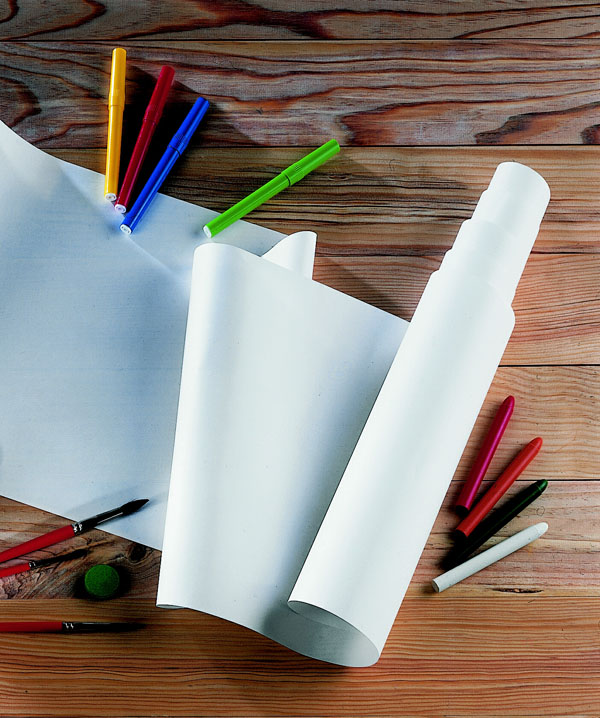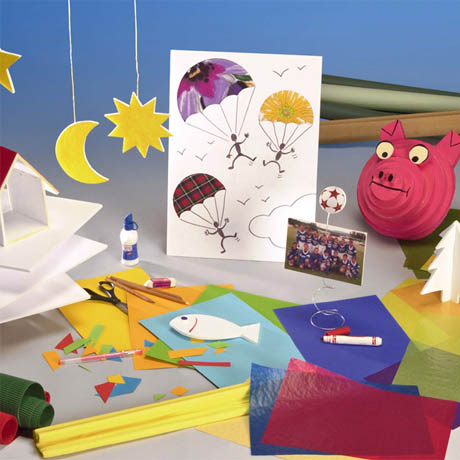Paper, cardboard, textures, colors, etc. Varied and attractive supplies will surely trigger an interest in artistic creation.
- Home
- Expert advice
- Activities for children: Select your materials

1. Paper
Explore with your child the large range of available fancy papers.
- Drawing: Available in multiple formats and in a wide variety of shades, it will offer an enhanced background to his drawings and take his cutouts and collages to the height of his ambitions.
- Metallised: enjoy its reflections to dress up Christmas subjects, masks, magic wands and other warrior weapons, made from cardboard.
- Stained glass or tracing paper: it partially lets light through while coloring it. Ideal for creating Chinese lanterns, lampshades, candlesticks (around a glass container), etc.
- Gum or adhesive: convenient for customized stickers, it will help the young ones decorate objects without risking stains from glue spots.
- Artisanal: already decorated and textured, thin or more thick, it becomes letter paper, book protection or lining material with a few scissor cuts.
- Crepe paper or tissue paper: straight out of our childhood, they have not changed a bit Use it to make paper flowers, sorcerer's wigs, skirts or fringed loincloths, garlands, etc.
- Log: it is the basis of the famous paper mache, etc. Found in stores, it also lends itself to making photo montages.

2. Other materials
- Cartons of variable thickness will serve as a basis for making boxes and various objects: pencil holders, photo montage frames, photo frames, etc.
- Corrugated cardboard makes a good material for making hats, masques, frames, etc.
- Felt and various textiles remain the best choices for making puppets. They are also good for original decorative cutouts.
- Colored foam: with a few strokes of the scissors, with a bit of glue and a zest of inventiveness, it becomes decorations for key chains or jewelry, coasters... and even "pizza for the dolls".
Tip: Less waste, recycle!
- Yogurt containers (in cardboard or glass) for pencil holders, candle holders, etc.
- Empty rolls from toilet paper or paper towels for figurines.
- Paper plates for masks.
- Boxes (for shoes or various others) that only need decorating.
- Egg cartons with honeycomb compartments for saving stickers, beads, etc.
And of course numerous other cartons and containers graciously sent to you with your online orders!

3. Paint
Favor water colors and water based paints. For the very young, finger painting is very practical; it can also be applied with a brush or roller.
- Favor the pellets over conventional tubes for children under 6 years of age, some contain enough of pigment to offer vivid color and good performance. Also practical are the large tubes of paint in a ready to use paste.
- Wait until age 10 to guide your child toward painting activities on specific bases (cloth, metal, glass and porcelain, etc.).
- Finnish his works with a water based varnish, also available in a sparkling version to add a decidedly festive note to his creations.
Tip: A brush for each use
The smaller the child, the larger the brush rather than shorter, and with a handle on which he will have a good grasp. The range of brushes made for schoolchildren is large enough to adapt to all their creative impulses.
- "Petit gris ronds" for all works involving diluting the colors,
- "Poney", more resistant, practical for decoration,
- Flat brushes for large colored surfaces or for working with paints in paste form.

4. Accessories
The essentials
- A plastic table cover and a washable work surface: sheet of plexiglass, plastic table set.
- at least a smock… or a complete budding artist outfit chosen from among his old clothes.
- A good pair of scissors, possibly a second with notched or zigzag blades, for fancy cuts. For small children look for plastic types. And put away your cutter!
- Pencils or classic mechanical pencils (HB) with large leads (at least 2B for cutting guides).
- Washable markers for small children, classic for bigger children.
- Ruler, eraser, possibly compass, square and protractor.
- White glue in a container for small children, then in a tube, ideally without solvent, and clothes pins or bulldog clips for holding assemblies in place.
And why not...
- Pastels: in stick form or crayon form, they let him draw in complete freedom.
- Wax sticks, a little fragile and usable on a variety of surfaces.
- Drawing gum: to create reserved areas, that can then be rubbed off with a finger, in his drawings and paintings.
- A glitter gel to be applied to paper and also to objects made from clay that dries hard.
Recommended product:
White drawing paper
Explore more tutorials on this technique
For kids
Making an Easter bunny
For kids
Make a present for Mother's Day
For kids
Create a paper pencil pot
For kids
Create masks
For kids
Make a Valentine's Day Gift
For kids
Make expressive faces out of paper
For kids
Make a corrugated cardboard parrot
For kids
Create corrugated cardboard totems
For kids
Making a paper hot-air balloon
For kids
Make a 3D paper landscape
For kids
Create a paper mandala
For kids
Make a paper mâché globe
For kids
Create a garland for April Fools Day
For kids
Make 3D toys out of paper
For kids
Make a chronological frieze
For kids
Make a paper cactus
For kids
Make a silhouette card
For kids
Making corrugated cardboard arrows
For kids
Drawing a Horse
For kids
Making a secret egg box from card
For kids
Drawing a boat
For kids
Create a botanical book
For kids
Create a four seasons picture
For kids
Create a star mosaic
For kids
Making a snowflake
For kids
Create a beautiful glittering star
For kids
Create a shape memory game
For kids
Drawing a Happy Dolphin
For kids
Drawing a Playful Dolphin
For kids
Drawing a Knight on Horseback
For kids
Drawing children
For kids
Drawing a Griffin
For kids
Drawing a Penguin
For kids
Drawing a Horse and Cart
For kids
Draw a soldier
For kids
Drawing a Foal
For kids
Drawing a turtle
For kids
How to make ladybirds
For kids
Drawing a castle
For kids
Set off to discover modern history
For kids
Create a pop-up card
For kids
Activities for kids: Graffiti
For kids
Activities for kids: Drawing a horse
For kids
Activities for kids: Drawing a cat
For kids
Activities for kids: Drawing a hand
For kids
Playing with one's children
For kids
Your children's graphic development
For kids
Drawing a Dragon
